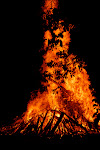
Our mission was to trek over three miles of undulating Atlantic coastline, following part of the route of the 1945 Barbados railway. We were one of three groups on the island taking part in the Worldwide Photowalk, established a year ago by American photographer and author Scott Kelby.
Our quest was to find interesting images that we would submit to the Worldwide Photowalk website to be adjudged with thousands of others from around the world.
The air was cool and an overnight rain had had its celebration, leaving its soggy stamp on the trail ahead. The first indication that this was going to be fun was trying to negotiate a narrow, sloping ledge of mud, the rim of a mini-precipice. The first few crossing did not have a problem, but rather created one for those of us following, as their footsteps compacted the mud into a smooth and eager trap. We clutched at overhanging branches, ending up with a fistful of wet leaves and still no support. Fortunately, we all survived this early test and became more interested in the terrain from a photographic point of view.
We soon came upon the first obvious sign of the old railway track. At a small watercourse, the coral block revetment on either side suggested that it once supported a short bridge. A flattened bed upon which the track once lay ran away from the revetment for about thirty feet before disintegrating into disorganized rubble. Scattered along this bed were bits of rusted iron, remnants of rails that were eventually shipped back to England.
We followed the twists and turns of our footpath, which sometimes coincided with the railway bed, though for most of the distance it meandered on its own course. We reached Glenburnie after about a forty-five minute stop-and-stare walk.The beach here comprised pebbles of varying colours and textures - the sort that would provide the perfect terrain for a huge aquarium.
It was here that we found the results of man’s intrusion into nature’s realm.
Lying entangled in a blue net was a lifeless turtle. My subsequent research suggested that this net, with its coarse, blue threading and wide spaces, is the trademark tool of the Japanese fishing fleet. As the nets disintegrate, turtles often get snared in these floating traps.
In this area of the coast in particular, bits of blue netting were clinging to the coral stacks that guarded the beach. Also lying among the beach pebbles were several dead fish, victims of water temperature change and other ecological phenomena according to the Fisheries Division.
Overlooking this beach was the crumbled ruin of a seaside house that seemed to have become a victim of salt-air erosion. It had occupied pride of place no more than about thirty feet from the high water mark, underscoring our fascination with trying to get a spot ‘on the beach’.
The trail then led us through groves of cane lily growth, providing cozy spots of shade in the journey. This serrated-edge lily, commonly known as Ping Wing, is used in basketry and mat making. It is also a formidable deterrent to intruders along the perimeter of some properties.


The frequency of meandering waterways, taking our precious resource to the ocean, was noticeable. The largest of these, is an outlet for water from the Newcastle Hills. It was once straddled by a 5-metre-high bridge, its supporting coral stone remnants still proudly standing.
We reached Congor Bay, a narrow sandy strip on the curving coastal border of the former Cable and Wireless satellite earth station. The end of trek was in sight as ahead was the casuarina-fringed beach leading to Bath. A disturbing sight was a number of uprooted casuarinas lying with scorched roots. Their demise may have been caused by fires started to prepare a meal of freshly caught fish. The shore line was slightly more friendly here with little nooks and crannies ideal for moments of quiet reflection in the gently lapping surf.
The little water flow over a 15-foot-high rock-face (some call it the Bath waterfall) and the beach houses opposite signaled that we had reached our destination. The coach waiting to take us back to our own transportation was a welcome sight – it meant that breakfast was only 15 minutes away.











